Welcome to an exploration of Positive Psychology – a field that sheds light on the pathways to human flourishing and well-being. In this article, we will embark on a journey through its introduction, tracing its origins and fundamental principles. We’ll explore the major theories that shape our understanding of happiness and fulfillment.
Our exploration will extend into The Science of Happiness, where we’ll uncover the mechanisms governing subjective well-being. We will then explore Positive Emotions and Resilience, highlighting the transformative power of optimism and resilience in facing life’s challenges. Next, we’ll search into Strengths and Virtues, revealing the inherent qualities driving personal growth.
Moving on to mindfulness, we’ll explore its synergy with Positive Psychology, revealing its impact on enhancing well-being. We will also investigate the importance of Positive Relationships and Social Connections in fostering happiness and resilience.
Turning to education and the workplace, we will explore Positive Education’s role in nurturing student well-being and organizational thriving.

Finally, we will examine the link between Positive Psychology and Mental Health, uncovering interventions that promote well-being and alleviate distress. Through this journey, we aim to illuminate the diverse facets of Positive Psychology and its profound impact on human flourishing.
Contents
- 1 Introduction
- 2 The Science of Happiness
- 3 Positive Emotions and Resilience
- 4 Strengths and Virtues
- 5 Mindfulness and Positive Psychology
- 6 Positive Relationships and Social Connections
- 7 Positive Education and Well-being in Schools
- 8 Positive Psychology in the Workplace
- 9 Positive Psychology and Mental Health
- 10 Conclusion
- 11 References
Introduction
Positive Psychology is the scientific study of factors that contribute to human thriving and well-being, focusing on promoting positive emotions, strengths, relationships, meaning, and accomplishments.[1]
In this section, we will explore
- Power of Positivity
- Positive Psychology V/s Traditional Psychology
- Positive Psychology Essentials
- Major theories in positive psychology
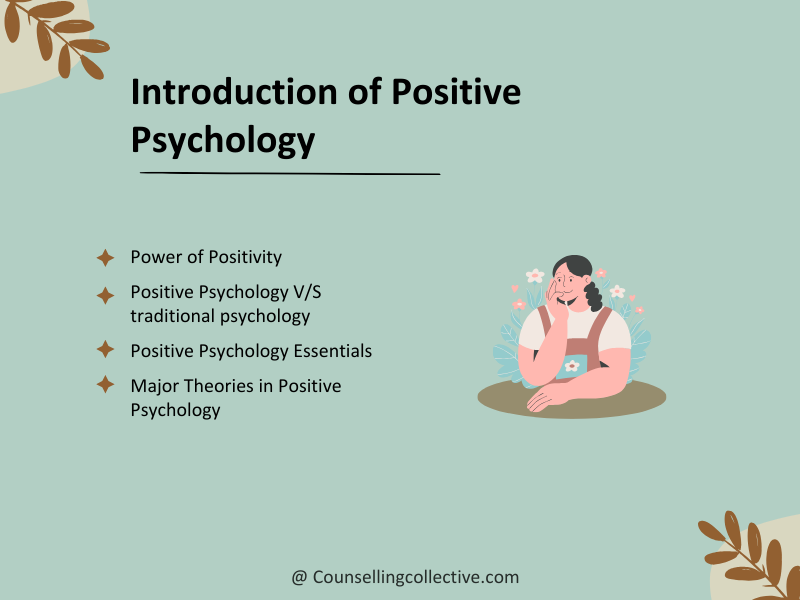
Power of Positivity
Recognizing the ‘Power of Positivity’ means understanding how positive thinking and attitudes can profoundly impact our well-being and success. It emphasizes the importance of nurturing optimism, resilience, and constructive behaviors to navigate life’s ups and downs.
Embracing this power allows us to build inner strength, overcome challenges, and flourish even in difficult times. By adopting a positive outlook and cultivating optimism, we can improve our mental health and relationships.
Ultimately, embracing the ‘Power of Positivity’ empowers us to live fulfilling lives and make positive contributions to the world around us
Positive Psychology V/S traditional psychology
| Positive Psychology | Traditional Psychology |
| Positive psychology focuses on enhancing positive aspects of the human experience | Traditional psychology focuses on diagnosing and treating mental illnesses and disorders |
| It investigates what makes life worth living and how individuals can thrive | It addresses negative aspects of human functioning |
| It emphasizes positive emotions, strengths, virtues, and experiences | It alleviates symptoms and improves functioning in individuals experiencing psychological distress |
| It promotes optimal functioning and fulfillment | It primarily aims to alleviate pathology and dysfunction |
| It emphasizes resilience, positive relationships, meaning, and accomplishments | It concentrates on pathology and dysfunction |
Positive Psychology Essentials
Positive Psychology research and practice encompass several key areas of focus that contribute to overall well-being. These areas include:
- Positive Emotions
Positive Psychology places a significant emphasis on studying and understanding positive emotions such as joy, gratitude, love, and contentment. Research shows that experiencing positive emotions not only enhances well-being but also has lasting effects on physical health, relationships, and overall life satisfaction.
- Character Strengths and Virtues
Positive Psychology explores the character strengths and virtues that enable individuals to thrive and reach their full potential. By identifying and leveraging their unique strengths, individuals can cultivate resilience, enhance performance, and navigate life’s challenges more effectively.
- Engagement and Flow:
Positive Psychology investigates the concept of engagement, which refers to the state of being fully immersed and absorbed in an activity. When individuals experience a sense of flow, they are engrossed in what they are doing, lose track of time, and feel a deep sense of satisfaction and fulfillment. Positive Psychology explores how individuals can create more opportunities for engagement and flow in their lives.
- Positive Relationships:
Building and nurturing positive relationships is a fundamental aspect of Positive Psychology. Research shows that having strong and supportive relationships contributes significantly to well-being and happiness. Positive Psychology explores the qualities and behaviors that foster positive connections, as well as the benefits of cultivating healthy and fulfilling relationships.
- Meaning and Purpose:
Positive Psychology recognizes the importance of finding meaning and purpose in life. When individuals have a sense of meaning and purpose, they experience greater satisfaction and fulfillment. Positive Psychology investigates how individuals can discover and live a meaningful life, aligning their actions with their core values and goals.
Major Theories in Positive Psychology
Positive Psychology has given rise to several major theories that provide frameworks for understanding and enhancing well-being. Some of the prominent theories in Positive Psychology include:
- Broaden-and-Build Theory
Developed by Barbara Fredrickson, this theory suggests that positive emotions broaden individuals’ minds and build their resources. Positive emotions, such as joy and gratitude, expand individuals’ cognitive, emotional, and social resources, leading to increased well-being and resilience.
- PERMA Model
Developed by Martin Seligman, the PERMA model focuses on five essential elements of well-being:
Positive Emotions, Engagement, Relationships, Meaning, and Accomplishments. According to this model, experiencing these elements in one’s life leads to a flourishing and fulfilling existence.
- Authentic Happiness Theory
Also proposed by Martin Seligman, this theory suggests that happiness is not solely dependent on external circumstances but can be cultivated through three main factors: pleasure, engagement, and meaning. It encourages individuals to pursue activities that please them, engage in activities that provide a state of flow, and live a life that aligns with their values and provides a sense of meaning.
- Self-Determination Theory
Developed by Edward Deci and Richard Ryan, this theory emphasizes the importance of intrinsic motivation, autonomy, and competence in promoting well-being. It suggests that individuals who have a sense of autonomy, feel competent in their pursuits, and have meaningful connections are more likely to experience greater well-being.[2]
The Science of Happiness
The Science of Happiness in Positive Psychology describes the systematic study of well-being, emphasizing strengths and virtues rather than solely focusing on pathology. By applying empirical research and evidence-based interventions, it aims to enhance individuals’ subjective well-being, resilience, and overall life satisfaction.
In this section, we will explore
- Happiness Measurement in Positive Psychology
- Factors in Well-being
- Cultivating well-being
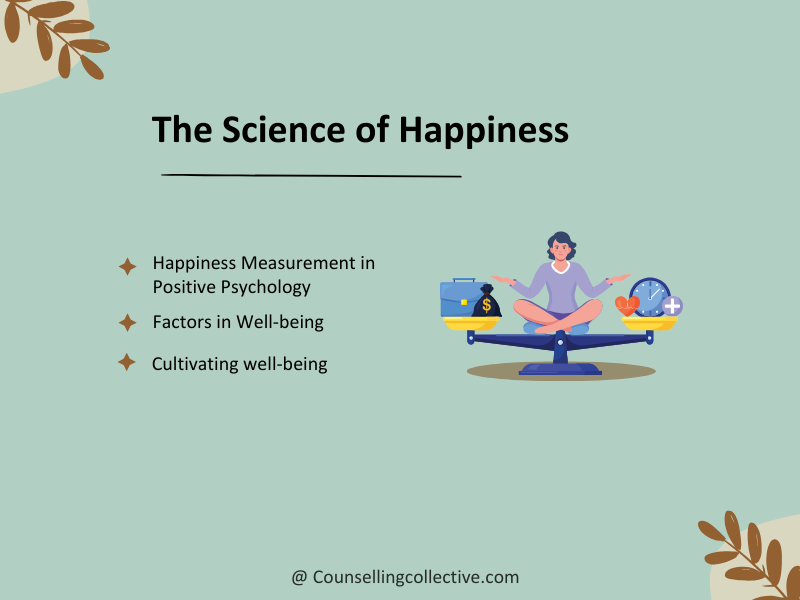
Happiness Measurement in Positive Psychology
Happiness is a complex and subjective experience that encompasses positive emotions, life satisfaction, and a sense of overall well-being. In Positive Psychology, happiness is not viewed as a fleeting emotion or a constant state of euphoria, but rather as a multidimensional construct that can be cultivated and measured.
Positive Psychology measures happiness through subjective assessments like the Subjective Well-Being (SWB) scale, capturing self-reported happiness and life satisfaction, and positive affect and negative affect scales, which assess the intensity of emotions. Objective indicators like social connectedness and physical health complement subjective measures, providing a holistic understanding. Researchers utilize various methodologies, including self-reports, observations, and physiological measurements, to comprehensively explore happiness and its determinants.
Factors in Well-Being
Subjective well-being, a key aspect of happiness, is influenced by various factors that contribute to an individual’s overall sense of happiness and fulfillment. Positive Psychology research has identified several important factors that significantly impact subjective well-being:
- Positive emotions and positive affectivity
Positive emotions play a crucial role in subjective well-being. Experiencing positive emotions, such as joy, gratitude, and contentment, contributes to overall happiness. Individuals with higher levels of positive affectivity tend to experience positive emotions more frequently and intensely, leading to greater subjective well-being.
- Life satisfaction and fulfillment
Life satisfaction is an individual’s cognitive evaluation of their overall life circumstances, including various domains such as work, relationships, and personal achievements. It reflects the extent to which individuals perceive their lives to be fulfilling and satisfying. When individuals feel satisfied with different areas of their lives, they tend to experience higher levels of subjective well-being.
- Engagement and flow
Engagement refers to the state of being fully absorbed and immersed in an activity, where one’s skills and challenges are in balance. When individuals are engaged in activities that align with their interests and strengths, they experience a sense of flow. Flow is characterized by intense focus, a loss of self-consciousness, and a deep sense of satisfaction. Engaging in activities that promote flow contributes to subjective well-being by enhancing feelings of competence and accomplishment.
Personal, social, and environmental factors interact and influence each other. Strong social connections and engaging in activities aligned with one’s values and interests can enhance positive emotions, life satisfaction, fulfillment, and subjective well-being.
Cultivating Well-Being
Cultivating happiness and well-being is a process that individuals can actively engage in to enhance their overall quality of life. Positive Psychology offers evidence-based strategies and practices that individuals can incorporate into their daily lives to promote happiness and well-being.
- Cultivating positive emotions
Individuals can consciously focus on increasing positive emotions by practicing gratitude, engaging in acts of kindness, and savoring positive experiences. Expressing gratitude regularly, whether through journaling or expressing appreciation to others, has been shown to boost happiness and well-being. Acts of kindness towards others, such as volunteering or helping a friend in need, not only benefit recipients but also increase one’s sense of well-being. Savoring positive experiences involves fully immersing oneself in the present moment and relishing the positive emotions associated with it.
- Nurturing relationships and social connections
Building and maintaining strong social connections is crucial for happiness and well-being. Engaging in meaningful relationships, spending quality time with loved ones, and seeking social support during challenging times can promote positive emotions and a sense of belonging. Actively fostering social connections through regular communication, participating in social activities, and cultivating empathy and compassion can contribute to long-term happiness and well-being.
- Pursuing meaningful goals and engagement
Setting and working towards meaningful goals can provide individuals with a sense of purpose and fulfillment. By identifying values and passions, individuals can align their goals with their core beliefs, leading to a greater sense of engagement and personal satisfaction. Additionally, engaging in activities that promote flow – a state of deep concentration and enjoyment – can enhance happiness. This can be achieved by finding activities that challenge skills, provide immediate feedback, and create a sense of absorption.
- Taking care of physical and mental well-being
Physical health and mental well-being are closely linked to happiness. Engaging in regular exercise, maintaining a balanced diet, and getting enough sleep are essential for overall well-being. Additionally, adopting stress management techniques such as meditation, mindfulness, and relaxation exercises can help individuals cope with daily challenges and enhance their resilience
- Practicing self-care and self-compassion
Taking care of oneself is crucial for happiness and well-being. This includes setting aside time for self-care activities that bring joy and relaxation, such as hobbies, leisure activities, or spending time in nature. Practicing self-compassion, which involves treating oneself with kindness and understanding in times of adversity or self-criticism, can also promote well-being and mental resilience.[3]
Positive Emotions and Resilience
Positive Psychology underscores the pivotal connection between positive emotions and resilience, elucidating their significance in fortifying psychological fortitude and adaptability. Through the cultivation of emotions such as gratitude, optimism, and joy, individuals can bolster their resilience, facilitating effective navigation through adversities and setbacks. Within the realm of Positive Psychology research, evidence supports the notion that fostering positive emotions contributes substantively to the cultivation of a resilient mindset, thereby promoting holistic well-being and mental resilience.
In this article, we will explore
- Positive Emotions’ Mental Impact
- Positive Emotions’ Resilience
- Promoting Resilience Through Positivity
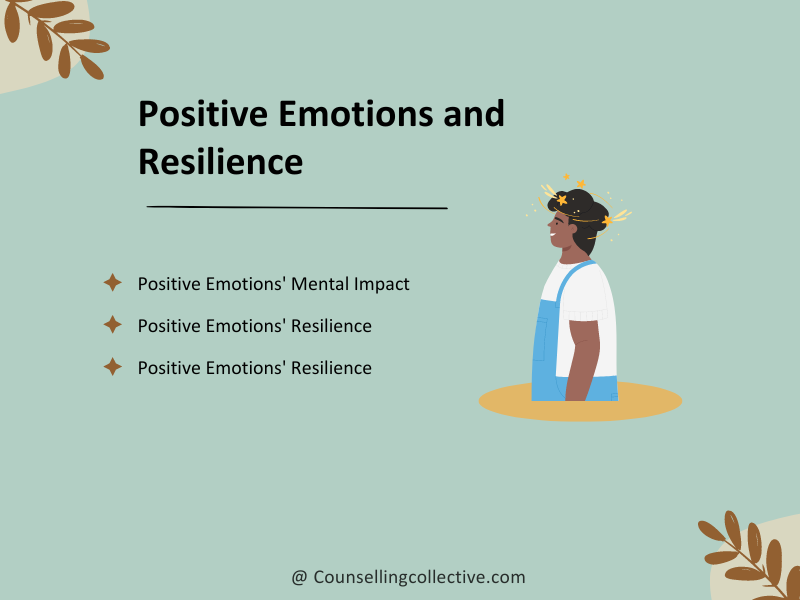
Positive Emotions’ Mental Impact
Positive emotions are uplifting and pleasant feelings, such as joy, gratitude, love, pride, and contentment. They bring forth feelings of pleasure, satisfaction, and optimism.
- Positive emotions enhance resilience and help us cope with stress and adversity.
- Regularly experiencing positive emotions is linked to higher levels of life satisfaction and overall psychological well-being.
- Positive emotions broaden our thinking and enhance creativity, leading to better problem-solving and decision-making abilities.
- They strengthen social connections by promoting empathy, kindness, and prosocial behaviors.
- Positive emotions have physical health benefits, including improved cardiovascular health, stronger immune system functioning, and reduced inflammation.
- Cultivating positive emotions is essential for maintaining a healthy and fulfilling life.
Positive Emotions’ Resilience
1. Building emotional resilience through positive emotions:
Positive emotions play a vital role in building emotional resilience, which refers to the ability to adapt and bounce back from challenging situations. Here are ways in which positive emotions enhance resilience:
- Broadening mindset: Positive emotions broaden individuals’ cognitive and emotional resources, allowing them to see a wider range of possibilities and solutions when faced with adversity. This expanded mindset enables more creative problem-solving and flexible thinking.
- Buffering against stress: Positive emotions act as buffers against the negative effects of stress. They help individuals regulate their emotions, maintain a positive outlook, and protect their mental well-being during difficult times.
- Promoting adaptive coping strategies: When experiencing positive emotions, individuals are more likely to engage in adaptive coping strategies that promote their well-being. These strategies can include seeking social support, practicing self-care, and engaging in activities that bring joy and fulfillment.
2. The role of gratitude, joy, and hope in overcoming adversity:
- Gratitude: Practicing gratitude involves recognizing and appreciating the positive aspects of life, even amid challenges. Gratitude helps individuals shift their focus from negative aspects to positive ones, fostering resilience and promoting a sense of well-being.
- Joy: Experiencing joy has a significant impact on resilience by providing individuals with a positive emotional state. Joy can be found in simple pleasures, hobbies, or spending time with loved ones. It helps individuals build resilience by creating positive memories and nurturing a sense of happiness and fulfillment.
- Hope: Hope is a positive emotion that involves having an optimistic outlook for the future and believing in the possibility of positive outcomes. It plays a crucial role in resilience by providing individuals with the motivation and determination to overcome adversity. Hope encourages individuals to set goals, develop strategies, and persevere in facing challenges.[4]
Promoting Resilience Through Positivity
To promote positive emotions and resilience, various interventions and practices can be implemented. These strategies aim to cultivate positive emotions, enhance coping abilities, and build resilience. Here are some effective interventions and practices:
1. Positive Psychology Interventions:
Positive psychology interventions focus on cultivating positive emotions and strengths to improve well-being and resilience. Some popular interventions include:
- Gratitude exercises: These involve writing down or expressing gratitude for things, people, or experiences that individuals are grateful for in their lives. This practice helps shift the focus towards positivity and fosters resilience.
- Positive journaling: Encouraging individuals to write about positive experiences, achievements, or moments of joy can boost positive emotions and resilience. This practice helps individuals reflect on the positive aspects of their lives and build a positive mindset.
- Acts of kindness: Engaging in acts of kindness towards others can generate positive emotions and strengthen social connections. These acts can be as simple as helping a colleague or volunteering for a cause. Such actions contribute to enhanced well-being and resilience.
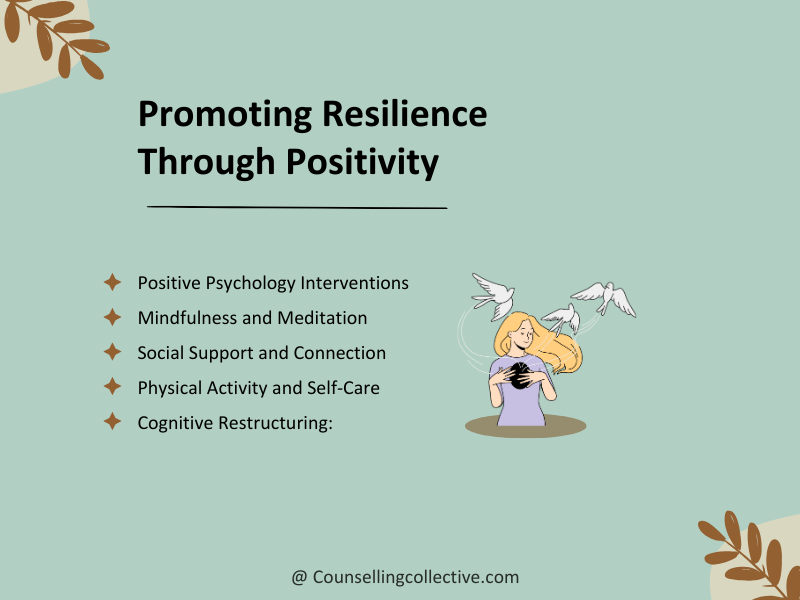
2. Mindfulness and Meditation:
Mindfulness practices involve intentionally paying attention to the present moment without judgment. These practices have been found to cultivate positive emotions and resilience by increasing self-awareness and reducing stress. Mindfulness meditation, breathing exercises, and body scans are effective techniques.
3. Social Support and Connection:
Building and maintaining strong social connections is essential for promoting positive emotions and resilience. Engaging in meaningful relationships, seeking support from loved ones, and participating in social activities can enhance well-being and buffer against adversity.
4. Physical Activity and Self-Care:
Regular exercise and self-care activities contribute to positive emotions and resilience. Physical activity releases endorphins, which are natural mood boosters. Taking care of one’s physical and mental health through activities like adequate sleep, healthy eating, and relaxation techniques also fosters resilience.
5. Cognitive Restructuring:
Cognitive restructuring involves challenging and reframing negative thoughts and beliefs into more positive and realistic ones. This technique helps individuals develop a more positive mindset, thereby promoting positive emotions and resilience.[5]
Strengths and Virtues
Positive psychology focuses on individual strengths and virtues to enhance well-being and foster personal growth through tailored interventions and practices.
Strengths are positive traits or qualities that are inherent to an individual’s character and contribute to their personal growth and well-being.
Virtues, on the other hand, are core moral qualities that guide individuals’ thoughts, actions, and behaviors. They encompass traits such as honesty, kindness, fairness, and wisdom.
In this section, we will explore
- Harnessing Personal Strengths for Growth
- The Impact of Strengths and Virtues on Well-being
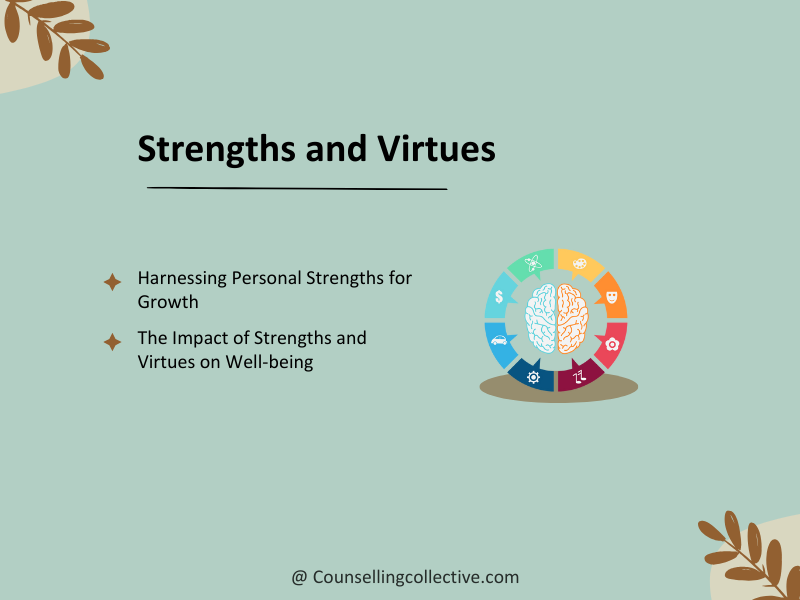
Harnessing Personal Strengths for Growth
Identifying and utilizing strengths is crucial for personal growth and well-being. Here are some strategies to help individuals identify and utilize their strengths:
- Self-reflection: Engaging in self-reflection allows individuals to identify their unique strengths. Reflecting on past successes, enjoyable activities, and moments of peak performance can provide insights into personal strengths.
- Strengths assessments: Various assessments, such as the VIA Character Strengths Survey, can help individuals identify their strengths. These assessments provide a framework for understanding and categorizing strengths, enabling individuals to leverage them effectively.
- Feedback from others: Seeking feedback from trusted friends, family, or colleagues can provide valuable insights into one’s strengths. Others may observe qualities in individuals that they may not be aware of, allowing for a more comprehensive understanding of their strengths.
- Experimentation and practice: Once strengths are identified, individuals can actively explore opportunities to utilize them. Engaging in activities that align with strengths allows individuals to develop and refine their skills, leading to personal growth and increased overall well-being.
The Impact of Strengths and Virtues on Well-being
Strengths and virtues play a significant role in contributing to overall well-being and life satisfaction. Here are some ways in which they contribute:
- Increased engagement:
When individuals utilize their strengths, they often experience a state of flow, characterized by deep engagement and enjoyment in activities. This leads to increased motivation, productivity, and a sense of fulfillment.
- Improved relationships:
Strengths-based interactions foster positive relationships. By recognizing and appreciating the strengths of others, individuals can build stronger connections and create a positive social environment.
- Resilience and coping:
Leveraging strengths enhances resilience and coping abilities. When faced with challenges, individuals can draw upon their strengths to find solutions, overcome obstacles, and navigate through adversity.
- Personal growth and self-esteem:
Utilizing strengths allows individuals to tap into their full potential, leading to personal growth and increased self-esteem. Recognizing and developing strengths provides a sense of purpose and accomplishment, contributing to overall well-being and life satisfaction.[1]
Mindfulness and Positive Psychology
Mindfulness is the practice of intentionally bringing one’s attention to the present moment without judgment. It involves being fully aware of one’s thoughts, emotions, bodily sensations, and environment. Mindfulness intersects with Positive Psychology as it aligns to cultivate positive emotions, enhance well-being, and promote resilience. By fostering non-judgmental awareness, mindfulness allows individuals to experience the present moment fully and engage in positive experiences more deeply.
Mindfulness Practices: Catalysts for Enhancing Well-being and Cultivating Positive Emotions
Mindfulness meditation and its benefits: Mindfulness meditation is a formal practice that involves focusing attention on the breath, bodily sensations, thoughts, or sounds while maintaining an attitude of non-judgmental awareness. This practice has been found to have numerous benefits for well-being and positive emotions, including:
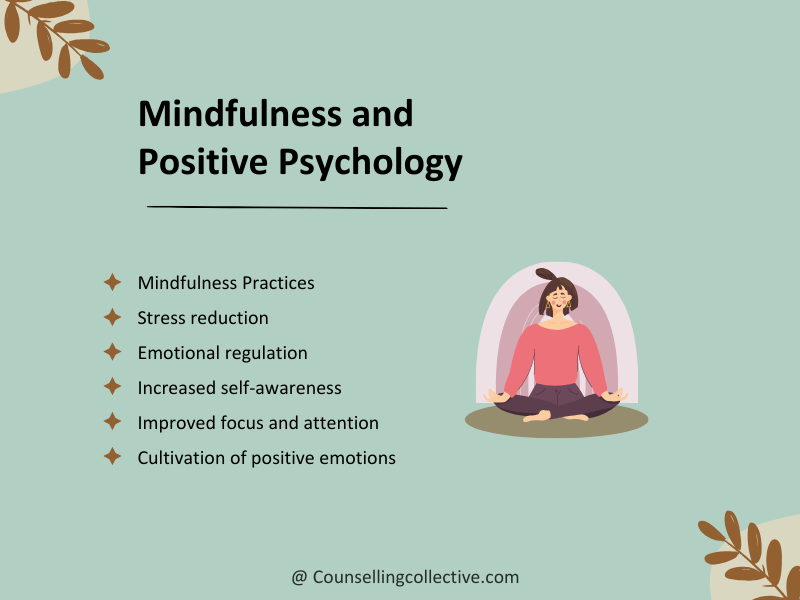
a. Stress reduction: Mindfulness meditation helps individuals develop a greater capacity to manage stress by cultivating a non-reactive and non-judgmental stance towards stressful thoughts and emotions. Regular practice can lead to reduced levels of perceived stress and increased emotional resilience.
b. Emotional regulation: Mindfulness meditation enhances emotional regulation by enabling individuals to recognize and accept their emotions without judgment. This practice allows individuals to respond to emotions more skillfully and adaptively leading to greater emotional well-being.
c. Increased self-awareness: Mindfulness meditation helps individuals better understand their thoughts, emotions, and behavioral patterns. By cultivating self-awareness, individuals can make conscious choices and engage in behaviors that align with their values, contributing to overall well-being.
d. Improved focus and attention: Through regular practice, mindfulness meditation enhances the ability to sustain attention and focus on the present moment. This can lead to improved concentration and productivity, as well as a greater capacity to fully engage in activities and relationships.
e. Cultivation of positive emotions: Mindfulness meditation has been found to increase positive emotions such as joy, gratitude, and compassion. By focusing on positive aspects of experience and cultivating an attitude of acceptance and non-judgment, individuals can experience a greater sense of well-being and happiness.[6]
Positive Relationships and Social Connections
Positive relationships play a crucial role in promoting overall well-being. Human beings are inherently social creatures, and our connections with others significantly impact our mental and emotional state. Positive relationships provide us with a sense of belonging, support, and emotional fulfillment. They contribute to our happiness, resilience, and overall life satisfaction. Research has consistently shown that individuals with strong and positive relationships tend to have better physical and mental health outcomes, lower levels of stress, and a higher sense of purpose and meaning in life. In this section, we will explore
- Social Connections: Key to Happiness
- Strategies for Cultivating and Sustaining Positive Relationships
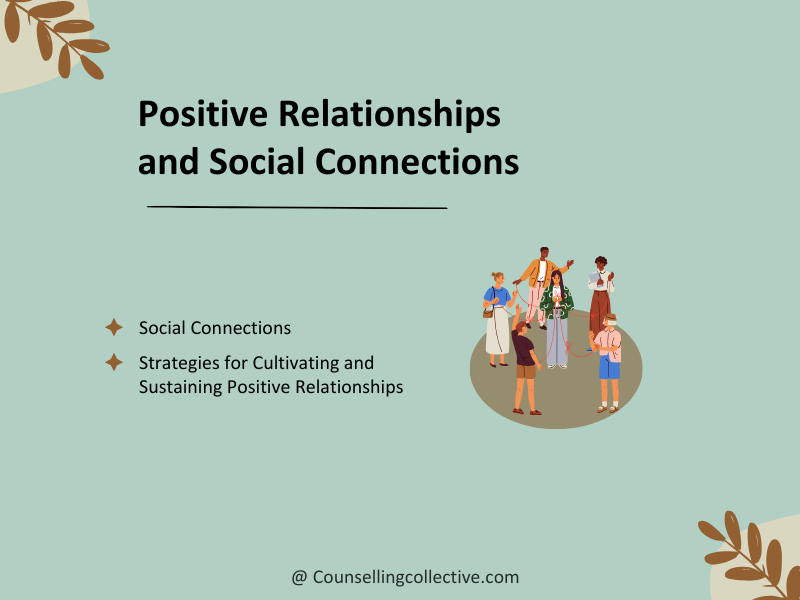
Social Connections: Key to Happiness
Social connections and support networks are essential contributors to happiness. When we have meaningful relationships and a support system, we experience a sense of security, belonging, and connectedness. Social connections provide opportunities for emotional expression, sharing experiences, and receiving support during challenging times. They offer a sense of validation, acceptance, and understanding, which can significantly enhance our well-being and happiness. Additionally, positive relationships can foster personal growth, provide opportunities for collaboration and learning, and offer a sense of purpose and fulfillment through shared activities and goals.
Strategies for Cultivating and Sustaining Positive Relationships
Building and maintaining positive relationships requires effort and intentionality. Here are some strategies to foster and nurture positive relationships:
1. Effective communication
Good communication skills are fundamental to building and maintaining positive relationships. Active listening, expressing empathy, and practicing open and honest communication can foster understanding, trust, and connection.
2. Quality time
Invest time and effort into nurturing relationships by spending quality time with loved ones. Engage in activities together, share experiences, and create meaningful memories. Quality time builds a sense of closeness and strengthens the bond.
3. Show appreciation and gratitude
Expressing appreciation and gratitude for the people in our lives can strengthen relationships. Acknowledge and thank others for their support, kindness, and positive impact. Small gestures of gratitude can go a long way in maintaining positive connections.
4. Practice empathy and understanding
Seek to understand others’ perspectives, needs, and emotions. Show empathy and offer support when someone is going through a difficult time. Being understanding and compassionate can deepen relationships and foster a sense of trust and security.
5. Resolve conflicts constructively:
Conflicts are inevitable in any relationship. When conflicts arise, approach them with a constructive mindset. Engage in open and respectful dialogue, seek compromise, and find solutions that satisfy both parties. Resolving conflicts healthily can strengthen relationships and build resilience.[7]
Positive Education and Well-being in Schools
Positive Psychology principles can be applied in educational settings by implementing positive education. Positive education incorporates the principles and practices of Positive Psychology into the school curriculum and environment, to promote well-being, resilience, and academic success among students. By integrating concepts such as gratitude, resilience, mindfulness, character strengths, and positive relationships into the educational framework, positive education seeks to create a nurturing and supportive environment that fosters the holistic development of students.
In this section, we will explore
- Positive Education: Enhancing Well-being and Performance
- Strategies for School Well-being: Positive Education Approaches

Positive Education: Enhancing Well-being and Performance
Positive education has been shown to have numerous benefits for student well-being and academic performance. Research has demonstrated the following advantages:
- Enhanced well-being: Positive education interventions, such as gratitude exercises, mindfulness practices, and character strengths development, have been found to increase positive emotions, reduce stress and anxiety, and improve overall well-being among students. By cultivating a positive mindset and providing tools for emotional regulation, positive education supports students’ mental health and happiness.
- Improved academic performance: Positive education is not just about well-being; it also has a positive impact on academic performance. When students are engaged, motivated, and emotionally balanced, they are more likely to excel academically. Positive education interventions, such as goal-setting, growth mindset, and self-efficacy exercises, can enhance students’ motivation, focus, and perseverance, leading to improved learning outcomes.
- Increased resilience: Positive education equips students with the skills and mindset to overcome challenges and bounce back from setbacks. By teaching resilience-building strategies, such as reframing adversity, developing problem-solving skills, and fostering a growth mindset, positive education helps students develop the resilience necessary to navigate the ups and downs of academic and personal life.
- Positive relationships and social skills: Positive education promotes positive relationships and social skills among students. By fostering a sense of community, encouraging collaboration, and providing opportunities for empathy and kindness, positive education cultivates a supportive and inclusive school environment. This, in turn, enhances students’ social skills, emotional intelligence, and ability to form positive relationships with peers and teachers.
Positive education has the potential to transform educational settings into nurturing and empowering environments that support the well-being and academic success of students. By incorporating Positive Psychology principles into the curriculum, educators can create a positive educational experience that fosters not only students’ academic growth but also their personal and emotional development.
Strategies for School Well-being: Positive Education Approaches
Promoting positive education and well-being in schools requires the implementation of various strategies and interventions. Here are some effective approaches:
- Curriculum Integration: Incorporate Positive Psychology principles such as gratitude, mindfulness, character strengths, and resilience into the school curriculum, offering students opportunities to learn and practice these concepts within their academic studies.
- Teacher and Staff Training: Provide comprehensive training and professional development sessions for educators and staff members to deepen their understanding of Positive Psychology principles and equip them with practical strategies to integrate these principles into their teaching practices and interactions with students.
- Mindfulness and Stress Reduction Programs: Implement mindfulness and stress reduction programs within the school setting, teaching students techniques for relaxation, stress management, and self-care. These programs can enhance focus, attention, and emotional regulation, contributing to overall well-being for both students and teachers.
- Character Strengths Development: Design programs aimed at identifying and fostering students’ character strengths. By helping students recognize and utilize their unique strengths in various aspects of their lives, such as academics and personal growth, these programs promote a positive self-concept and resilience.
- Positive School Climate and Culture: Foster a positive school climate and culture by creating an environment where students feel valued, respected, and supported. Implement initiatives such as anti-bullying programs, peer mentoring, and collaborative activities to cultivate empathy, teamwork, and a sense of belonging.
- Family Involvement: Engage families in promoting positive education and well-being by providing resources, workshops, and opportunities for parents to support their children’s emotional and academic growth. Encourage open communication between school and home to create a cohesive partnership in fostering student well-being.
- Evaluation and Assessment: Regularly assess the effectiveness of positive education initiatives through data collection on student well-being, academic performance, and satisfaction. Use this information to make informed decisions, refine strategies, and ensure continuous improvement in promoting positive education within the school community.[8]
Positive Psychology in the Workplace
Positive Psychology in the workplace promotes employee well-being and engagement through strengths-based approaches, fostering a positive work culture that enhances productivity and fulfillment.
In this section, we will explore
- Boosting Employee Well-being and Productivity
- Strategies for Cultivating a Positive Work Environment
- Integrating Positive Psychology Principles into Organizational Culture
Boosting Employee Well-being and Productivity
Positive Psychology principles can have a significant impact on employee well-being and productivity in the workplace. Here are some ways in which Positive Psychology can make a difference:
- Fostering a positive mindset: Positive Psychology encourages employees to adopt a positive mindset by focusing on their strengths, cultivating gratitude, and practicing optimism. This perspective shift helps employees approach challenges with resilience, problem-solving skills, and a sense of empowerment, leading to improved well-being and productivity.
- Enhancing work-life balance: Positive Psychology emphasizes the importance of achieving a healthy work-life balance. By promoting self-care, mindfulness, and stress reduction techniques, employees are better equipped to manage their workload, reduce burnout, and maintain overall well-being. This, in turn, leads to increased productivity and job satisfaction.
- Encouraging positive relationships: Positive Psychology recognizes the importance of positive relationships in the workplace. By fostering a culture of respect, collaboration, and support, employees feel valued and connected. Positive relationships with colleagues and supervisors contribute to a positive work environment, increased job satisfaction, and improved productivity.
- Promoting employee engagement: Positive Psychology interventions, such as goal-setting, feedback, and recognition, can enhance employee engagement. When employees feel that their work is meaningful and aligned with their strengths, they become more motivated, focused, and productive. Positive Psychology interventions also encourage a growth mindset, which fosters continuous learning and development, further contributing to employee engagement.
- Enhancing leadership effectiveness: Positive Psychology principles can be applied to leadership practices, resulting in improved leadership effectiveness. By focusing on strengths-based leadership, fostering positive relationships with employees, and providing support and development opportunities, leaders can create a positive work environment that promotes employee well-being and productivity.
Strategies for Cultivating a Positive Work Environment
Creating a positive work environment requires intentional strategies and actions. Here are some effective strategies for fostering positivity in the workplace:
- Promote open communication: Encourage open and transparent communication among employees and between employees and management. Provide opportunities for feedback, suggestions, and discussions to create an inclusive and collaborative work environment.
- Cultivate a supportive culture: Foster a culture that values and supports employee well-being. Provide resources and programs that promote physical and mental health, work-life balance, and personal development. Encourage employees to take breaks, practice self-care, and prioritize their well-being.
- Recognize and appreciate employees: Implement recognition programs that acknowledge and appreciate employees’ contributions and achievements. Regularly celebrate milestones, accomplishments, and efforts. This cultivates a sense of appreciation, motivation, and job satisfaction among employees.
- Encourage professional growth and development: Provide opportunities for employees to enhance their skills, knowledge, and professional growth. Offer training programs, mentorship opportunities, and career development initiatives. This shows employees that their growth is valued, increasing their commitment and satisfaction.
- Foster positive relationships: Encourage teamwork, collaboration, and positive relationships among employees. Create opportunities for social interactions, team-building activities, and cross-functional projects. This helps to build a positive and supportive work environment.
- Lead by example: Leaders play a crucial role in creating a positive work environment. Demonstrate positive behaviors, such as open communication, empathy, and appreciation. Encourage a positive mindset, growth mindset, and the use of strengths. This sets the tone for the entire organization and influences employee well-being and productivity.
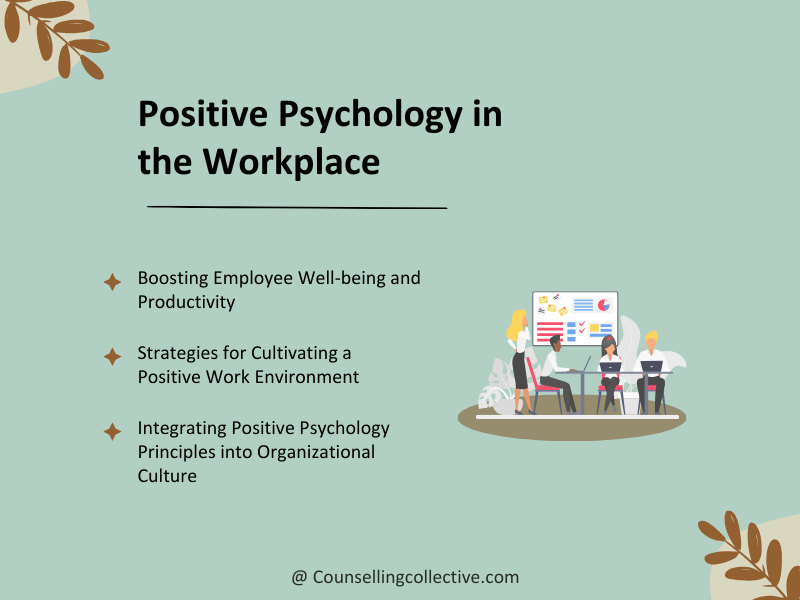
Integrating Positive Psychology Principles into Organizational Culture
Incorporating Positive Psychology principles into the culture and practices of an organization is essential for creating a positive work environment. Here are some ways organizations can do this:
- Leadership commitment: The commitment of leaders is crucial in integrating Positive Psychology into the organizational culture. Leaders should embrace and model Positive Psychology principles themselves, demonstrating behaviors such as optimism, gratitude, and empathy. By doing so, they inspire and motivate employees to adopt these principles as well.
- Alignment with organizational values: Integrate Positive Psychology principles into the organization’s core values and mission. Ensure that these principles are reflected in the decision-making processes, policies, and practices of the organization. This alignment reinforces the importance of positive well-being and productivity as key components of the organization’s overall success.
- Training and development programs: Provide training and development programs that educate employees about Positive Psychology principles and how to apply them in their work. Offer workshops, seminars, or online courses that teach practical techniques for fostering well-being, resilience, and positive relationships. This empowers employees to incorporate these principles into their daily work routines.
- Strengths-based approach: Adopt a strengths-based approach in talent management and performance evaluations. Encourage employees to identify and utilize their strengths in their roles, which promotes engagement, satisfaction, and productivity. Provide opportunities for employees to develop and apply their strengths through projects, cross-functional teams, or stretch assignments.
- Feedback and recognition: Implement feedback and recognition practices that focus on strengths and positive achievements. Provide timely and specific feedback that highlights employees’ strengths and contributions. Recognize and celebrate accomplishments, fostering a culture of appreciation and encouragement. This reinforces positive behaviors and motivates employees to continue performing at their best.
- Well-being initiatives: Develop and implement well-being initiatives that prioritize employees’ physical, mental, and emotional health. Offer resources and programs that promote work-life balance, stress management, mindfulness, and overall well-being. Encourage employees to take breaks, practice self-care, and prioritize their health, which contributes to their overall satisfaction and productivity.
- Continuous improvement and evaluation: Regularly assess and evaluate the effectiveness of Positive Psychology initiatives and practices within the organization. Collect feedback from employees and use data to measure the impact of these initiatives on employee well-being and productivity. Make adjustments and improvements based on the findings to ensure ongoing success.[9]
Positive Psychology and Mental Health
Positive Psychology analyzes the fostering of strengths, positive emotions, and meaningful connections to improve mental well-being. It complements traditional therapy by emphasizing strengths and empowering individuals to take an active role in their mental health journey, leading to more holistic treatment experiences.
In this section, we will explore
- Mental Health Promotion & Prevention
- Interventions for Mental Health Challenges
- Positive Psychology & Traditional Therapy Integration
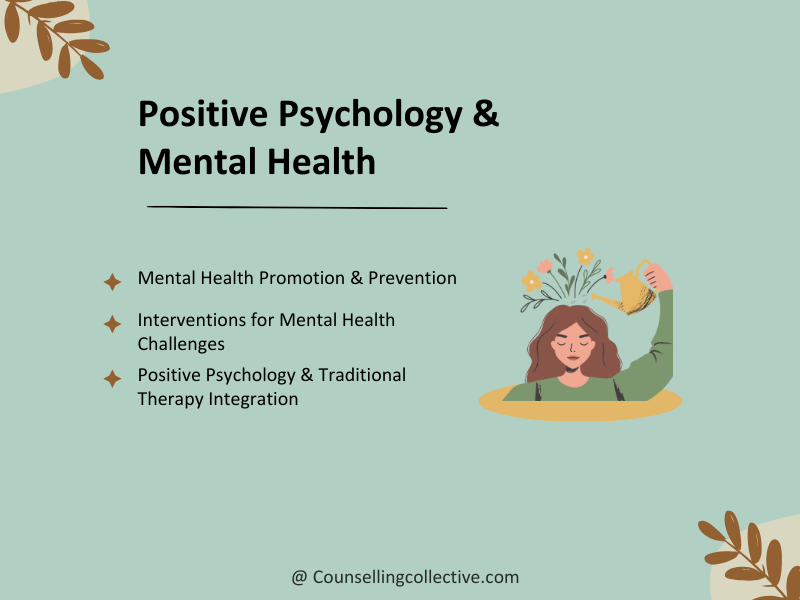
Mental Health Promotion & Prevention
Positive Psychology plays a significant role in promoting and preventing mental health challenges. These are some ways in which Positive Psychology contributes to mental health promotion and prevention:
- Focus on strengths and resilience: Positive Psychology emphasizes the identification and cultivation of individual strengths and resilience. By recognizing and leveraging personal strengths, individuals develop a sense of self-efficacy and optimism, which can serve as protective factors against mental health difficulties. This focus on strengths also helps individuals navigate challenges and setbacks more effectively.
- Cultivation of positive emotions: Positive Psychology interventions aim to enhance positive emotions such as joy, gratitude, and hope. Engaging in activities that promote positive emotions has been linked to increased overall well-being and a reduced risk of mental health problems. By cultivating positive emotions, individuals can build emotional resilience and better cope with stressors.
- Nurturing positive relationships: Positive Psychology recognizes the importance of positive relationships in mental health promotion and prevention. Meaningful connections and social support act as buffers against mental health challenges. Encouraging individuals to build and maintain positive relationships fosters a sense of belonging, support, and overall well-being.
- Mindfulness and self-compassion: Positive Psychology interventions often incorporate mindfulness and self-compassion practices. Mindfulness helps individuals to be present, non-judgmental, and accepting of their thoughts and emotions, reducing stress and enhancing overall mental well-being. Self-compassion promotes self-care, self-acceptance, and self-kindness, which are crucial for maintaining mental health.
Interventions for Mental Health Challenges
Positive Psychology offers valuable interventions and practices for individuals facing mental health challenges. Here are some strategies that can be helpful:
- Gratitude journaling: Encourage individuals to keep a gratitude journal, where they can write down things they are grateful for each day. This practice helps shift focus toward positive aspects of life, fostering a more optimistic outlook and reducing symptoms of depression and anxiety.
- Positive affirmations: Encourage individuals to engage in positive self-talk by using affirmations. Encouraging them to repeat positive statements about themselves can help build self-esteem, self-confidence, and a more positive mindset.
- Engaging in meaningful activities: Encourage individuals to identify and engage in activities that bring them joy and fulfillment. This can include hobbies, volunteering, or pursuing personal goals. Engaging in meaningful activities promotes a sense of purpose and satisfaction, contributing to overall mental well-being.
- Mindfulness-based stress reduction: Introduce individuals to mindfulness practices, such as meditation or deep breathing exercises. These techniques can help individuals manage stress, reduce anxiety, and improve overall mental health by cultivating present-moment awareness and acceptance.
- Positive social connections: Encourage individuals to seek support from positive and understanding individuals in their social network. This can include joining support groups, engaging in social activities, or seeking professional counseling. Positive social connections provide emotional support, validation, and a sense of belonging, which are crucial for mental health recovery.
- Strengths-based therapy: Incorporate a strengths-based approach in therapy interventions. Help individuals identify and leverage their strengths to overcome challenges and build resilience. By focusing on their strengths, individuals can regain a sense of control and agency, contributing to their mental health recovery.
Positive Psychology & Traditional Therapy Integration
Positive Psychology can effectively complement traditional approaches to therapy and treatment by providing a more holistic and strengths-based perspective. Here are several ways in which Positive Psychology can enhance traditional approaches:
- Focus on well-being: While traditional approaches to therapy often focus on addressing and alleviating mental health issues, Positive Psychology goes beyond symptom reduction and places a strong emphasis on promoting overall well-being. By incorporating Positive Psychology principles into therapy, individuals can not only work towards resolving their challenges but also develop the skills and mindset needed to thrive and lead fulfilling lives.
- Strengths-based approach: Positive Psychology encourages individuals to identify and leverage their strengths, talents, and resources. Traditional therapy often focuses on identifying and addressing weaknesses or vulnerabilities. By adopting a strengths-based approach, therapists can help individuals build on their existing strengths, enhancing their self-esteem, confidence, and resilience. This approach empowers individuals to recognize their capabilities and find solutions to their challenges.
- Positive reframing: Positive Psychology encourages individuals to reframe negative experiences or situations in a more positive light. This cognitive shift can help individuals find meaning, growth, and resilience in the face of adversity. By integrating positive reframing techniques into therapy, individuals can learn to challenge negative thought patterns and develop a more optimistic and resilient mindset.
- Enhancing positive emotions: Positive Psychology interventions focus on cultivating positive emotions such as gratitude, joy, and hope. Integrating these interventions into traditional therapy can help individuals develop a more positive and balanced emotional state. By consciously incorporating positive emotions into their daily lives, individuals can counteract negative emotions and enhance their overall well-being.
- Mindfulness and self-compassion: Positive Psychology places a strong emphasis on mindfulness and self-compassion practices, which can complement traditional therapy techniques. Mindfulness helps individuals develop present-moment awareness and acceptance, reducing stress and enhancing overall well-being. Self-compassion promotes self-care, self-acceptance, and self-kindness, providing individuals with valuable tools to navigate their challenges with kindness and understanding.
- Prevention and resilience-building: Positive Psychology interventions can be particularly valuable in prevention and resilience-building efforts. By incorporating Positive Psychology principles into therapy, individuals can learn skills and strategies to proactively enhance their mental health and well-being. This can include stress management techniques, positive relationship-building skills, and resilience-building exercises. By focusing on prevention and resilience-building, therapists can support individuals in developing long-term strategies for maintaining good mental health.[10]
Conclusion
Positive Psychology is a field that promotes mental health by focusing on overall well-being. It enables individuals to develop resilience, find purpose, and experience greater life satisfaction. Positive Psychology emphasizes positive emotions, relationships, and personal strengths, which significantly contribute to mental well-being.
In this article, we have explored Positive Psychology’s role in mental health. We have discussed how it promotes mental health through strengths identification, fostering positive emotions, nurturing relationships, and encouraging mindfulness and self-compassion. Additionally, we have outlined various interventions stemming from Positive Psychology that aid individuals in facing mental health challenges such as gratitude exercises, positive affirmations, and strengths-based therapy.
It is crucial to integrate Positive Psychology principles into our lives proactively to enhance our mental health and overall well-being. By embracing strengths-based approaches, practicing gratitude, nurturing relationships, and engaging in meaningful activities, we can promote our mental health and build resilience. Incorporating these techniques into therapy can provide a more holistic and empowering therapeutic experience.
Although incorporating Positive Psychology into our lives requires dedication and practice, it yields significant rewards. By embracing these principles, we not only enhance our well-being but also positively impact those around us. Let’s harness the power of Positive Psychology to create a ripple effect of positivity and take proactive steps toward our happiness and fulfillment.
References
- .Seligman, M. E. P., & Csikszentmihalyi, M. (2000). Positive psychology: An introduction. American Psychologist, 55(1), 5–14.
- Peterson, C., & Seligman, M. E. P. (2004). Character strengths and virtues: A handbook and classification. Amazon
- Diener, E., Oishi, S., & Tay, L. (2018). Handbook of Well-being. WordPress
- Lyubomirsky, S. (2007). The how of happiness: A scientific approach to getting the life you want. Amazon
- Sin, N. L., & Lyubomirsky, S. (2009). Enhancing well-being and alleviating depressive symptoms with positive psychology interventions: A practice-friendly meta-analysis. Journal of Clinical Psychology, 65(5), 467–487.
- Brown, K. W., & Ryan, R. M. (2003). The benefits of being present: Mindfulness and its role in psychological well-being. Journal of Personality and Social Psychology, 84(4), 822–848.
- Diener, E., & Seligman, M. E. P. (2002). Very happy people. Psychological Science, 13(1), 81–84.
- Green, S., & Norrish, J. (2018). Positive education: Evidence-based approaches to improving wellbeing in schools.
- Dutton, J. E., & Ragins, B. R. (2007). Exploring positive relationships at work: Building a theoretical and research foundation. GoogleBook
- Wood, A. M., Froh, J. J., & Geraghty, A. W. A. (2010). Gratitude and well-being: A review and theoretical integration. Clinical Psychology Review, 30(7), 890–905.
